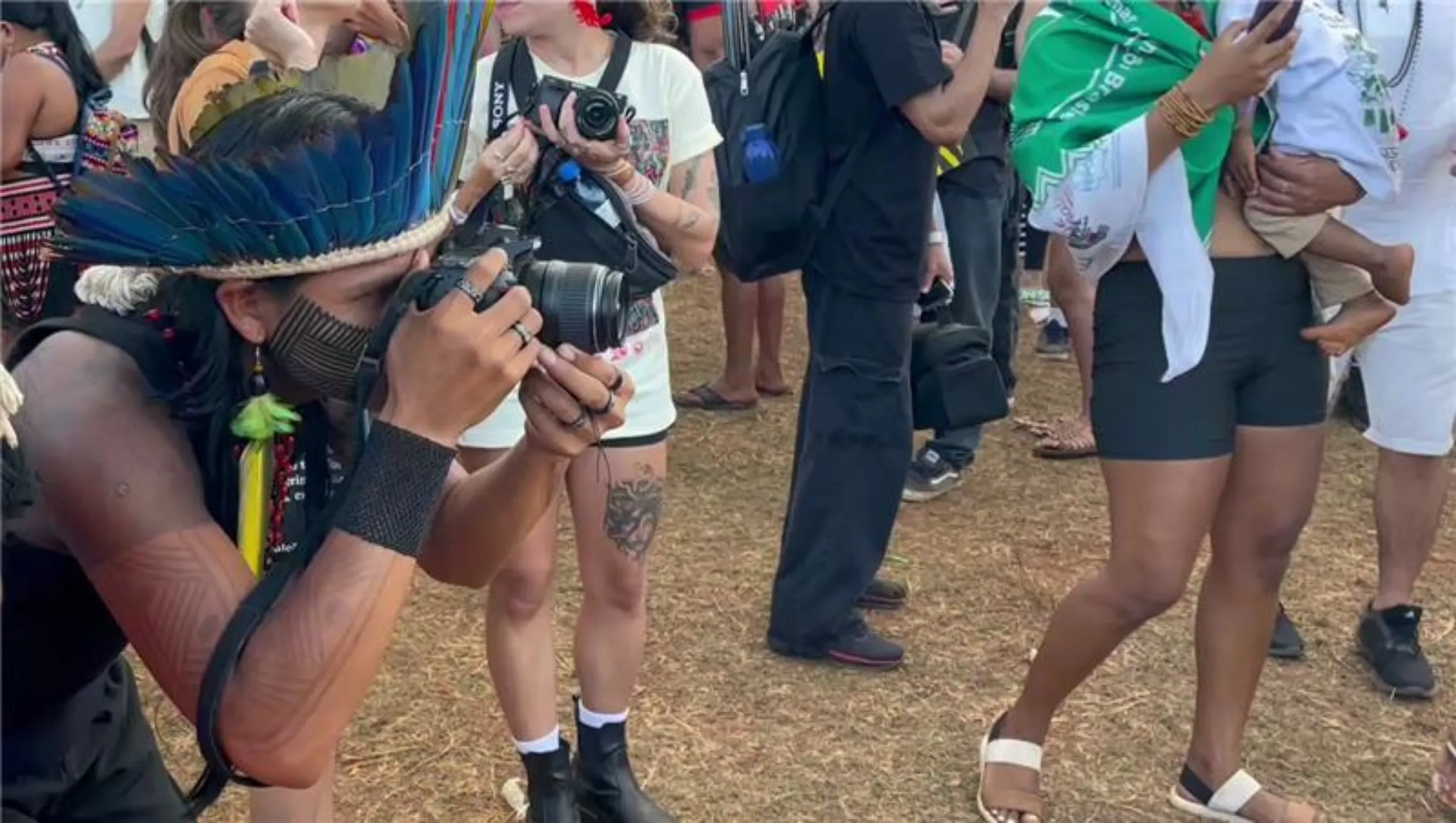Brazil's Indigenous artists use film making to fight for rights

An Indigenous person takes photos from protestors at the Free Land Camp in Brasilia, Brazil, April 10, 2025. Thomson Reuters Foundation/André Cabette Fábio
What’s the context?
Brazil's Indigenous movement use film and social media to promote land rights and promote culture at rally event.
- Indigenous filmmakers share their art at Brazil gathering
- Film is being used in struggles for Indigenous land rights
- Indigenous artists can illustrate strength, legitimacy of their cause
BRASILIA - At Brazil's largest Indigenous gathering in the nation's capital this week, filmmakers are illustrating how cinema and social media can spotlight their culture and struggles as they demand protection for land rights.
On a recent rainy evening, about two dozen film enthusiasts sat on stands alongside a projector, one them Amazon filmmaker Takumã Kuikuro watching a ritual of the Fulni-ô people.
The Fulni-ô live in northeastern Brazil, where they, like most Indigenous people, have been embroiled in longtime battles over their land rights.
"Indigenous cinema is an instrument for fight," said Takumã, who also showed his short film "Jungle Fever" about a shaman and his son facing wildfires.
"We are developing it so we can be seen by the world, not only in theatres here, but also in TikTok, YouTube and other media," he said.
More than 7,000 people from more than 150 Indigenous ethnic groups are attending the annual five-day Free Land Camp, according to organizers, where they campaign against legislation that could make it impossible for some groups to reclaim territory they have been forced to leave.

Indigenous filmmaker Takumã Kuykuro watches virtual reality video from Hugo Fulni-ô at the Free Land Camp in Brasilia, Brazil, April 10, 2025. Thomson Reuters Foundation/André Cabette Fábio
Indigenous filmmaker Takumã Kuykuro watches virtual reality video from Hugo Fulni-ô at the Free Land Camp in Brasilia, Brazil, April 10, 2025. Thomson Reuters Foundation/André Cabette Fábio
Attendees include a growing number of Indigenous artists who, like the award-winning filmmaker Takumã, are making movies displayed in festivals in Brazil and abroad.
Indigenous content producers also sustain a network of influencers on social media, where they report on the fight of the Indigenous movement for land, which is deeply connected to the protection of nature and the Amazon rainforest in Brazil.
In Takumã's Kuikuro village, film making was first promoted by the peoples' chief, who he said was concerned that youth were losing interest in their own culture.
The chief wanted films made to document and preserve Kuikuro culture, including Indigenous rituals like their singing.
"Our community knows how important it is for us to make these films ourselves," Takumã said, as rain drummed down onto a plastic tarp overhead and a concert and small rave were staged nearby.
"When white people came to make movies about us, they didn't really know what was relevant."
Self-representation
As with many of his generation, Takumã's first film making lessons started through the Vídeo nas Aldeias (Video in the Villages) project.
Launched in 1987 by French-Brazilian filmmaker Vincent Carelli, the project has led to the creation of dozens of films.
Now owner of his own film production company, Xingu Filmes, Takumã is producing a series of short films on life in the Xingu Indigenous Territory in Brazil's Amazon, where he lives.
Another filmmaker at the Free Land Camp, Hugo Fulni-ô, screened his "Toré Virtual" short.
His film transports viewers to a woodland clearing in an arid Indigenous village, where alternating generations of four men shake marakás and women sing.
Films "give support to our cultures, safeguarding them to new generations", said Hugo, who also took part in the Vídeo nas Aldeias project.
More recently, advocates and activists linked to Brazil's Indigenous rights movement have formed extensive collectives that produce content on their cultures and real-time coverage of protests and attacks against their communities.
At the Free Land Camp in 2017, they launched Mídia Indígena, a media collective that now has more than 251,000 followers on Instagram and more than 560,000 followers on TikTok.
According to Mídia Indígena, content is produced by a network of 780 communicators across Brazil.
Their work has covered Indigenous issues that mainstream media in Brazil have ignored, said filmmaker and photographer Priscila Tapajowara, who is president of Mídia Indígena.
"We were the first to talk about invasions, such as the Yanomami Indigenous territory," Tapajowara said.
The land where the Yanomami live in the Amazon rainforest has been under assault by illegal small-scale miners for gold and other minerals who have felled forests, polluted the water and brought deadly diseases, according to the United Nations Human Rights Office of the High Commissioner.
Brazil's largest Indigenous umbrella organization, Apib, which organises the Free Land Camp, has its own official media channels, supported by broadcasters from its seven member organizations who take photos and post stories on social media about the Indigenous gathering.
One of them is photographer Richard Wera Mirim, manager of the Guarani Yvyrupa Commission's Instagram account, with more than 25,000 followers.
The advantage of having Indigenous communicators is not only their ability to show the struggles of the Indigenous movement but rather their strength and the legitimacy of their cause, he said.
"If the story is about tragedy, about Indigenous people getting killed, it will be shown on television. But if it's about our fair fight for territory, about exposing invasions, it won't get the same coverage," he said.
"As communicators, we have the obligation to show that on social media."
(Reporting by Andre Cabette Fabio; Editing by Anastasia Moloney and Ellen Wulfhorst.)
Context is powered by the Thomson Reuters Foundation Newsroom.
Our Standards: Thomson Reuters Trust Principles
Tags
- Adaptation
- Climate inequality
- Forests
- Communicating climate change
- Indigenous communities



















